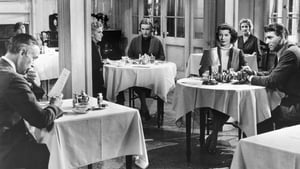Contact: [email protected]
Video Sources 0 Views

Synopsis
Review: In Separate Tables 1958 – Exploring the Impact of Early Colorized Films

Introduction
Welcome to the world of In Separate Tables 1958, a classic piece of cinema that has recently resurfaced in an early colored version. In this article, we delve into the significance of this edition, exploring how colorization affects the viewing experience and its broader implications in film history.
Check The Full Colorized Movies List
Check Our Colorized Movies Trailer Channel
Understanding In Separate Tables 1958: Director, Cast, and Genre
Directed by Delbert Mann, In Separate Tables 1958 is a poignant drama that showcases the nuances of human relationships. With a stellar cast including luminaries like Burt Lancaster, Rita Hayworth, Deborah Kerr, and David Niven, the film boasts performances that have stood the test of time. Set against the backdrop of a British seaside hotel, the movie weaves together multiple storylines, each delving into themes of loneliness, deception, and redemption. Its genre can be classified as a romantic drama, though it delves into deeper psychological territory.
Exploring the World of In Separate Tables 1958: Plot and Characters
The film unfolds within the confines of a cozy hotel, where a diverse group of guests find themselves intertwined in a web of secrets and desires. David Niven shines as Major Angus Pollock, a retired army officer harboring a dark secret. His interactions with the other guests, particularly Deborah Kerr’s Sibyl Railton-Bell, reveal layers of complexity and vulnerability. Rita Hayworth’s portrayal of Ann Shankland, a former model seeking refuge from her tumultuous past, adds another dimension to the narrative. As the characters grapple with their inner demons, the film offers a poignant exploration of human frailty and resilience.
The Art of Film Colorization
Film colorization, the process of adding color to black-and-white footage, has been a subject of much debate in the film industry. While some argue that it breathes new life into classic films, others contend that it detracts from the director’s original vision. The technique has evolved significantly since its inception, with modern advancements allowing for more accurate color reproduction. However, the decision to colorize a film remains a contentious issue, with purists advocating for the preservation of the original black-and-white format.
Early Colored Films: A Brief History
The concept of coloring films dates back to the early days of cinema, with hand-tinting techniques used to add color to individual frames. However, it wasn’t until the advent of Technicolor in the 1930s that color films became commercially viable. These early colored films revolutionized the industry, paving the way for future innovations in cinematography and visual storytelling.
In Separate Tables 1958 and Its Early Colored Version
The decision to release In Separate Tables 1958 in a colorized format marks a significant departure from its original presentation. While purists may argue that it compromises the director’s artistic vision, others see it as an opportunity to introduce classic films to a new generation of viewers. The early colored version of the film seeks to enhance the viewing experience, adding depth and dimension to the narrative without overshadowing the original performances.
The Debate Over Film Colorization
The debate over film colorization is as old as the technique itself, with proponents and detractors voicing their opinions on its merits and drawbacks. While some argue that it allows for greater accessibility and engagement, others believe that it diminishes the historical integrity of classic films. As technology continues to advance, the debate rages on, highlighting the complex relationship between art and innovation.
Examining In Separate Tables 1958 as an Early Colored Film
As one of the first black-and-white films to receive the colorization treatment, In Separate Tables 1958 provides a unique opportunity to explore the impact of this technique on the viewing experience. While the early colored version offers a fresh perspective on the film, it also raises questions about the authenticity of the adaptation. Ultimately, the success of colorization hinges on its ability to complement the director’s original vision without overshadowing it.
Influence and Legacy: In Separate Tables 1958‘s Impact on Cinema
Despite the controversy surrounding its colorized release, In Separate Tables 1958 remains a timeless classic that continues to inspire audiences and filmmakers alike. Its exploration of universal themes and complex characters has cemented its place in cinematic history, paving the way for future generations of storytellers. Moreover, the film’s influence can be seen in the resurgence of romantic dramas and ensemble casts in contemporary cinema.
Director’s Cinematic Legacy: Beyond In Separate Tables 1958
Delbert Mann’s contribution to cinema extends far beyond In Separate Tables 1958, with a diverse body of work that spans multiple genres and styles. From intimate character studies to sweeping epics, Mann’s films reflect a keen understanding of human nature and the human condition. His legacy serves as a testament to the power of storytelling and the enduring impact of cinema on our lives.
Themes Explored in In Separate Tables 1958
In Separate Tables 1958 delves into a myriad of themes, including love, betrayal, and redemption. Against the backdrop of a seaside hotel, the film explores the intricacies of human relationships, exposing the vulnerabilities and insecurities that lie beneath the surface. Its nuanced portrayal of characters and their struggles resonates with audiences to this day, offering a timeless reflection on the human experience.
Reception and Controversy Surrounding In Separate Tables 1958
Upon its release, In Separate Tables 1958 received critical acclaim for its performances and storytelling. However, the decision to release an early colored version of the film sparked controversy among purists and cinephiles. While some welcomed the opportunity to experience the film in a new light, others lamented the loss of its original aesthetic. Nevertheless, the film’s enduring legacy and cultural impact cannot be denied, cementing its status as a cinematic masterpiece.
Where to Watch In Separate Tables 1958 Online
For those eager to experience the timeless charm of In Separate Tables 1958, the film is readily available on popular streaming platforms such as Amazon Prime Video and iTunes. Whether you choose to watch it in its original black-and-white format or the early colored version, the film promises to captivate and enthrall audiences with its compelling narrative and stellar performances.
FAQs About In Separate Tables 1958
Q: Is In Separate Tables 1958 based on a true story? A: While the film is not directly based on real events, it draws inspiration from various sources, including the play of the same name by Terence Rattigan.
Q: Who are the main actors in In Separate Tables 1958? A: The film features a star-studded cast, including Burt Lancaster, Rita Hayworth, Deborah Kerr, and David Niven.
Q: What is the significance of the film’s early colored version? A: The early colored version of In Separate Tables 1958 offers a fresh perspective on the film, enhancing the visual experience while staying true to the director’s original vision.
Conclusion
As we conclude our exploration of In Separate Tables 1958, it becomes evident that the film’s enduring legacy transcends its colorization controversy. Whether viewed in its original black-and-white format or the early colored version, the film continues to captivate audiences with its timeless themes and compelling performances. As viewers, we are reminded of the importance of preserving cinematic treasures like In Separate Tables 1958 and honoring the director’s artistic vision. In the end, it is not the color of the film that matters, but the depth of its storytelling and the impact it leaves on our hearts and minds.












